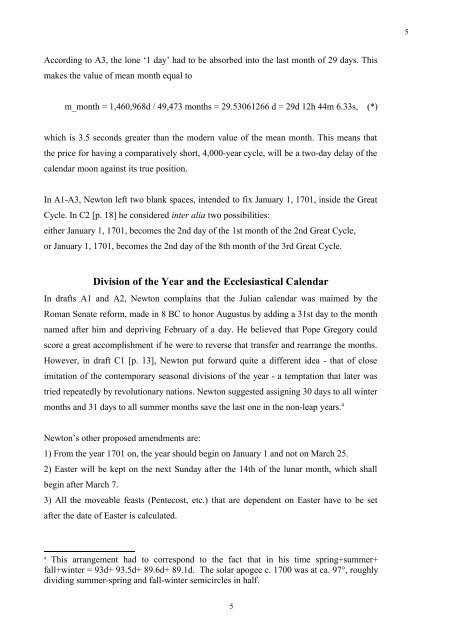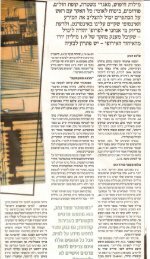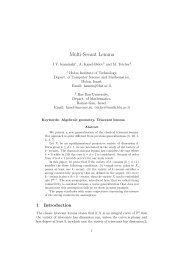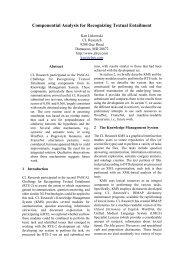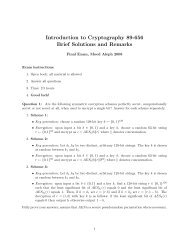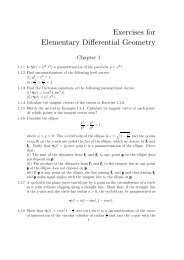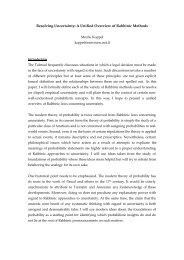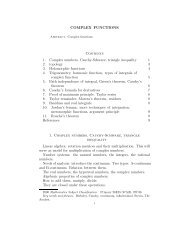Reform of the Julian Calendar as Envisioned by Isaac Newton
Reform of the Julian Calendar as Envisioned by Isaac Newton
Reform of the Julian Calendar as Envisioned by Isaac Newton
You also want an ePaper? Increase the reach of your titles
YUMPU automatically turns print PDFs into web optimized ePapers that Google loves.
5<br />
According to A3, <strong>the</strong> lone ‘1 day’ had to be absorbed into <strong>the</strong> l<strong>as</strong>t month <strong>of</strong> 29 days. This<br />
makes <strong>the</strong> value <strong>of</strong> mean month equal to<br />
m_month = 1,460,968d / 49,473 months = 29.53061266 d = 29d 12h 44m 6.33s, (*)<br />
which is 3.5 seconds greater than <strong>the</strong> modern value <strong>of</strong> <strong>the</strong> mean month. This means that<br />
<strong>the</strong> price for having a comparatively short, 4,000-year cycle, will be a two-day delay <strong>of</strong> <strong>the</strong><br />
calendar moon against its true position.<br />
In A1-A3, <strong>Newton</strong> left two blank spaces, intended to fix January 1, 1701, inside <strong>the</strong> Great<br />
Cycle. In C2 [p. 18] he considered inter alia two possibilities:<br />
ei<strong>the</strong>r January 1, 1701, becomes <strong>the</strong> 2nd day <strong>of</strong> <strong>the</strong> 1st month <strong>of</strong> <strong>the</strong> 2nd Great Cycle,<br />
or January 1, 1701, becomes <strong>the</strong> 2nd day <strong>of</strong> <strong>the</strong> 8th month <strong>of</strong> <strong>the</strong> 3rd Great Cycle.<br />
Division <strong>of</strong> <strong>the</strong> Year and <strong>the</strong> Ecclesi<strong>as</strong>tical <strong>Calendar</strong><br />
In drafts A1 and A2, <strong>Newton</strong> complains that <strong>the</strong> <strong>Julian</strong> calendar w<strong>as</strong> maimed <strong>by</strong> <strong>the</strong><br />
Roman Senate reform, made in 8 BC to honor Augustus <strong>by</strong> adding a 31st day to <strong>the</strong> month<br />
named after him and depriving February <strong>of</strong> a day. He believed that Pope Gregory could<br />
score a great accomplishment if he were to reverse that transfer and rearrange <strong>the</strong> months.<br />
However, in draft C1 [p. 13], <strong>Newton</strong> put forward quite a different idea - that <strong>of</strong> close<br />
imitation <strong>of</strong> <strong>the</strong> contemporary se<strong>as</strong>onal divisions <strong>of</strong> <strong>the</strong> year - a temptation that later w<strong>as</strong><br />
tried repeatedly <strong>by</strong> revolutionary nations. <strong>Newton</strong> suggested <strong>as</strong>signing 30 days to all winter<br />
months and 31 days to all summer months save <strong>the</strong> l<strong>as</strong>t one in <strong>the</strong> non-leap years. 4<br />
<strong>Newton</strong>’s o<strong>the</strong>r proposed amendments are:<br />
1) From <strong>the</strong> year 1701 on, <strong>the</strong> year should begin on January 1 and not on March 25.<br />
2) E<strong>as</strong>ter will be kept on <strong>the</strong> next Sunday after <strong>the</strong> 14th <strong>of</strong> <strong>the</strong> lunar month, which shall<br />
begin after March 7.<br />
3) All <strong>the</strong> moveable fe<strong>as</strong>ts (Pentecost, etc.) that are dependent on E<strong>as</strong>ter have to be set<br />
after <strong>the</strong> date <strong>of</strong> E<strong>as</strong>ter is calculated.<br />
4<br />
This arrangement had to correspond to <strong>the</strong> fact that in his time spring+summer+<br />
fall+winter = 93d+ 93.5d+ 89.6d+ 89.1d. The solar apogee c. 1700 w<strong>as</strong> at ca. 97°, roughly<br />
dividing summer-spring and fall-winter semicircles in half.<br />
5


